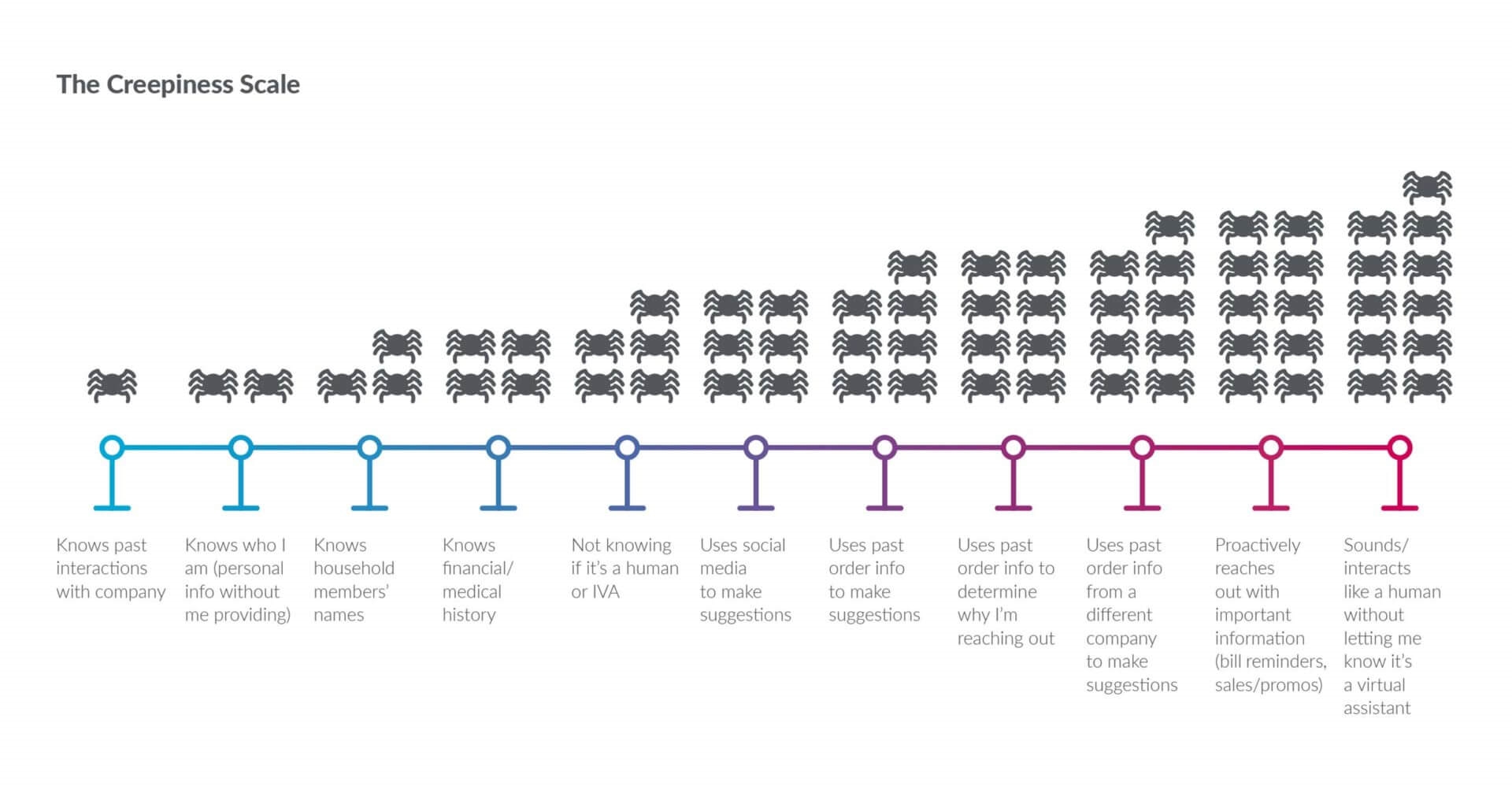Creeping out your customers is bad for business. Here’s how to message without going over the line.
Things are getting a little scary out there.
With the use of artificial intelligence (AI) to micro-target customers across multiple platforms at an all-time high, its no wonder that consumers are starting to feel a little creeped out. Add to that persistent reports of data misuse by major social platforms and virtual assistants going rogue with personal information and consumers don’t need Halloween to be scared — they just need to log on.
A majority of consumers — 75 percent — said they find personalized brand experiences at least somewhat creepy, with 22 percent opting to look for other less-creepy brands and 9 percent saying they’d leave a negative review, according to an InMoment 2018 CX Trends Report (free with registration) released earlier this year.
Andrew Park, InMoment’s vice president of customer experience strategy says “there’s a fine line between ‘creepy’ and ‘cared for,’ and the emotional and financial impact of missing the mark can precipitate long-lasting damage to the customer relationship.”
How can marketers use personalization without going over the line?
First, let’s define where that line is. Intelligent virtual assistant (IVA) provider Interactions teamed up with The Harris Poll to conduct a survey of 2,000 consumers in the U.S. aimed at determining where the “creepy” line is, and when AI crosses it.
The ensuing report (free with registration) showed that consumers say they are put off when an AI system knows information they didn’t provide directly, or that involves other people in their social networks. The survey found that about half of those surveyed think it’s creepy when:
- AI knows other household members’ past interactions with a company (52 percent).
- It uses social media data to make suggestions (50 percent).
- It knows past purchase history from a different company (42 percent).
“When it comes to using AI, marketers struggle to find the line between what their customers find helpful and where things get creepy,” said Interaction’s SVP of Marketing Jane Price. “Navigating that line can make it tough to implement AI in a way that is beneficial. Yet the promise of AI is so powerful that it warrants the extra effort it takes to strike the right balance and use it in a way that’s both effective and respectful.”
Here’s what marketers can do to make consumers feel less creeped out.
Keep it simple. Alex Krylov, senior privacy analyst at Cheetah Digital says a proliferation of trackers such as cookies have made marketers hungry for more data than they need.
“I think the first step for me is saying to marketers: Don’t be a blood-sucking, data-sucking vampire,” Krylov said. “You don’t necessarily need to hoard data today for some imaginary value in the future. Try to understand what your needs are in terms of your marketing strategy and try to minimize the data you collect from consumers to get to that goal.”
Be honest. In its report, Interactions pointed out that consumers like to feel in control, or at least know how their information is being used.
“The easiest way for marketers to not cross the line is to prioritize transparency and only use information given directly by the customer, not gleaned from third-parties,” Interactions’ Price said. “The moment that a brand starts to use information that a customer doesn’t remember providing, that’s when customers start to think its creepy.”
Brands should let customers know when they’re speaking with a virtual assistant or bot and not a person. “Being upfront with customers about when AI is in use can help enhance trust in your brand,” added Price.
Show value. “When a brand asks for personal information, it often explicitly promises that they’ll provide ‘a better customer experience’ in exchange,” InMoment’s Park said. “The problem is that often brands’ definition of a better experience consists of retargeted ads or poorly executed email campaigns that offer little if any value to their customers.”
The good news is consumers say they want personalized experiences. Roughly 40 percent of respondents to the Harris Poll/Interactions survey said they find it helpful when AI knows their past interactions with a company, uses past order history to make suggestions, proactively reaches out with important information such as bill pay reminders or sales, or uses past order history to determine why they are contacting them.
And a majority of consumers (72 percent) will tolerate “invasive” AI if it alerts them to an issue, or helps them resolve a problem.
Park said, “The key to avoiding the creepy factor is remarkably simple: Keep customers’ data safe and deliver real value — as defined by the customer, and not your digital marketing metrics.”
Don’t exploit consumers’ trust. Though most customers are happy to give up personal data when they see a benefit, brands that exploit that trust could suffer dire consequences, warns Park.
“When brands sacrifice the relationship on the altar of demand gen greed, not only do they see a sad return on their marketing dollar investment, they damage the relationship. At best, the data tells us, your customers will warn their networks about your creepy tactics. At worst, their lifetime value will plummet, and 22 percent say they’ll leave altogether,” said Park.
His parting advice: “Adhere to the mantra of ‘reciprocal benefit’ and you won’t scare your customers away.”
Marketing Land – Internet Marketing News, Strategies & Tips
(99)
Report Post









